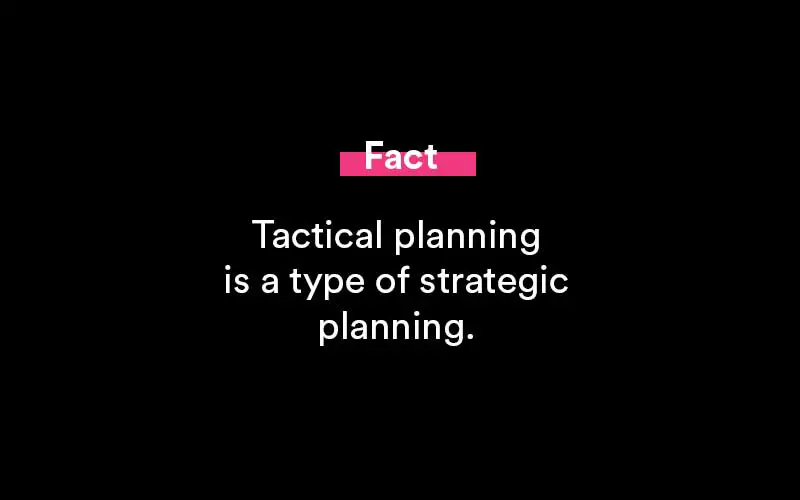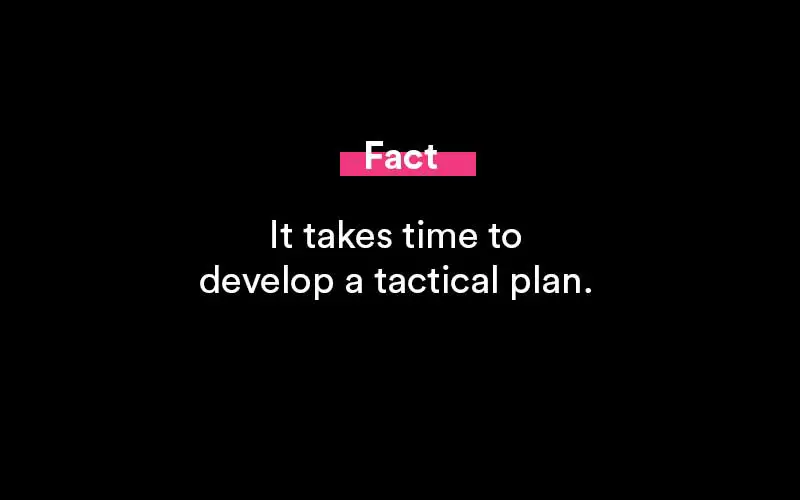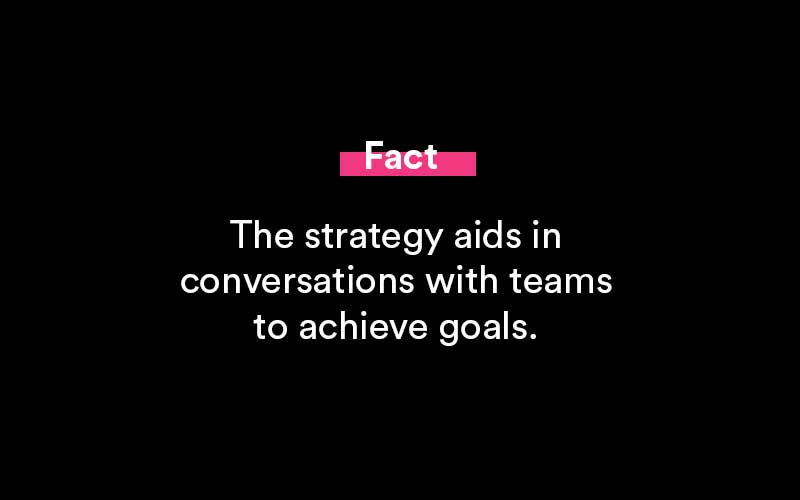Tactical Planning - Definition, Examples, Process
What is tactical planning? Tactical planning is the process of breaking down a long-term strategic plan into smaller, more specific short-term goals. When a company or a team has a long-term goal that spans more than two or three years, they typically employ this sort of strategy. Focused goals, methods to achieve those goals, and a timetable are all important components of a tactical strategy.

What's tactical planning?
Tactical planning is the process of breaking down a strategic plan into smaller objectives and goals after a company or team has created one. A tactical plan is used to identify objectives and decide how they will be met through various activities and processes. Most tactical plans detail precise measures or actions that will be performed to achieve the strategic plan's objectives. To guarantee that these tasks or processes are completed on time, they are frequently delegated to the relevant team members or workers.
Tactical planning is used most often when a company or team has to respond quickly to an issue or scenario. A company that wishes to win a bid from another company, for example, must develop a credible plan that would be successful. This proposal is frequently written utilizing a tactical plan that entails a series of minor measures, such as lowering the offer price, to aid the company in winning the bid from the competitors.

When to use a tactical plan
The following scenarios are ideal for tactical planning:
- When you need to make a quick business choice.
- When a strategic plan is in place and a team or company has to figure out how to get to the strategic plan's objectives.
- When a diversion plan is required to find opportunities or avoid problems.
- When a company or team aims to achieve short-term outcomes rather than long-term results.
- In a nutshell, tactical planning is most often utilized to achieve short-term goals or objectives.
Elements of a tactical plan
The most important elements of a successful tactical plan are as follows:
Goals
The goals of a tactical strategy are the most important part of it. SMART goals are ideal in most instances since they guarantee that each goal is clearly stated and attainable. Specific, Measurable, Attainable, Relevant, and Time-bound is an acronym that stands for Specific, Measurable, Attainable, Relevant, and Time-bound. A tactical strategy should include short-term targets that can be accomplished in a year or less. These objectives, on the other hand, can be met in order to support a long-term objective that is part of a strategic plan.
Begin by determining the first step necessary to achieve each target in your tactical strategy. Then, for each objective, break it down into smaller steps that will eventually lead to its completion. To enhance the chances of achieving a goal, make sure it is practical, measurable, and has a deadline.

Tactics
A tactic is a technique you employ to fulfill each of the objectives you set forth in your tactical plan. For example, if your goal is to develop a new product package for clients over the next year, surveying clients about the types of products they find most beneficial and conducting A/B testing for product packaging to determine which type of packaging is most successful are two tactics that would help you achieve that goal.
Tactics usually don't have deadlines and are just meant to help you achieve your objectives. Tactics are not steps, but rather more broad activities that will be done in order to achieve the goal.
Actions
The activities that will be done to achieve each goal are another important aspect of a tactical strategy. Actions are defined actions or tasks that must be done in order to progress towards a goal's accomplishment. Using the preceding situation as an example, steps to support the aim of establishing a new product bundle can include making a list of the items that will be included in the package and agreeing on the package's pricing.
Resources
The resources that will be necessary to accomplish each step of the tactical plan are another essential aspect of the strategy. Materials, equipment, new workers, funds, and outsourcing are all examples of resources necessary to complete the tasks in the plan. For example, if one of your tactical plan's tasks is to compile a list of items that will be included in a product package, the resources you'll need are time and the product list.
Timeline
Another important component of a tactical strategy is a timeframe or deadline. A deadline must be set for each job or activity in your tactical plan. Without a deadline, determining which work is the most important and should be completed first might be difficult. A timeline allows you to arrange activities or actions in the order in which they must be performed in order to achieve your objectives.
Benefits of a tactical plan
Tactical plans aid in the implementation of strategic planning at all levels of a business.
Some of the most important advantages of a tactical strategy are as follows:
- This sort of strategy aids in the conversion of plans into actions that assist an organization or team achieve its objectives.
- It fosters better performance since employees and team members will have concrete actions to follow in order to achieve their objectives.
- It enables departments and teams to prioritize their tasks while also ensuring that each job is aligned with the broader plan.
- This sort of approach encourages company-wide participation and can increase staff engagement.
- Advantages and disadvantages of a tactical strategy.
Disadvantages of a tactical plan
Here are a few probable tactical planning drawbacks:
- It takes time to develop a tactical strategy, and in certain situations, you can wind up spending more time preparing than really accomplishing.
- If the tactical plan is broad, it can cause a company's activities to slow down.
- To guarantee that a team or company's goals are accomplished, everyone must contribute. When one employee or team member fails to perform their work on time, the entire process might be slowed.
Common questions
Common questions about strategic planning.
What's an example of a tactical plan?
There are a number of tactical planning examples to walk through. A company's strategic plan often describes the objectives and go-to-market plan.
Assume for a minute that your business offers insurance in a big metropolitan region. Your insurance company's tactical marketing strategy should detail, step by step, each marketing component required to achieve the strategic plan's goals and vision.
For example, if you conclude that one of the greatest methods to reach your target customer is through television advertising, the tactical strategy must detail the specifics of the television campaign. Choosing an acceptable message, arranging for the creation of the commercial, selecting what channels to broadcast the commercial on and when, and following up with potential consumers who respond to the campaign are all steps in building this strategy.
What is strategic and tactical planning? And the differences?
A strategic plan outlines the high-level approach to accomplish the organization's vision and mission statements. Strategic plans, on the whole, give a comprehensive, long-term view. Top management analyzes financial, operational, and external environment information to project future actions in order to build strategic goals. The creation of tactical plans is influenced by strategic plans.
A tactical plan responds to the question, "How do we carry out our strategic plan?" It lays planned steps to attain short-term objectives, usually within a year or fewer. They have a considerably smaller scope and can be split down into departments or units. Tactical plans spell out what each department must accomplish, how it must do so, and who is in charge of putting the plan into action.
Do tactical plans vary between company and department?
While strategic and tactical plans differ by company and sector, many sales organizations and teams can benefit from them. Here are a few examples that are frequently used by sales teams and representatives.

Popular Resources

Featured
35+ Phone Interview Questions & Best Sample Answers
Phone interviews have become a core part of the process when attempting to find a secured placement for an open position. Companies receive massive responses from potential candidates for any..

Featured
12+ Best Questions To Ask A Recruiter
Concerning a job search, you might receive numerous offers from your recruiters. Before you choose one, you need to assess all the conditions, for which it is vital that you know everything associated with the offered position..

Featured
Answering "What Makes You Unique" In A Job Interview
Answering this question during a job interview requires more than knowing why you are unique as an individual. Yes, the true scientific answer is made up of two main components: your..

Featured
250+ Ice Breaker Questions for Life
An ice breaker question is a question that’s asked from one person to another person in order to act as a conversation starter. It brings a connection...

Featured
10 Best Answers to "What Motivates You?"
Open-ended questions like “What motivates you?” can elicit a deer-in-the-headlights reaction from job candidates if they are unprepared. It’s a broad question and can leave the interviewer..

Featured
Answering "How Did You Hear About This Position" In An Interview
A lot of interviewers ask this question - how did you hear about this position? This way they can judge you if you are a passive or an active job seeker..

Featured
8 Best Thank You Emails After an Interview (Samples, Free Templates)
Writing a thank you note after an interview says a lot about you as a potential employee. Most notably, it says that you care about the opportunities presented..

Featured
Writing a Resignation Letter (How To Write It, Samples)
Writing the perfect letter of resignation is more of an art than it is a science. And we’re going to cover how to master that art form in this full guide..

Featured
How to End a Letter (Example Salutations, Sign Off's)
Knowing how to end a business note or email is an important skill to develop. It helps portray a sense of confidence, respect and tone to your message..
